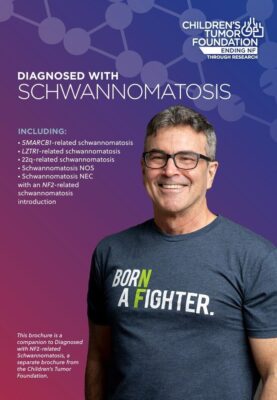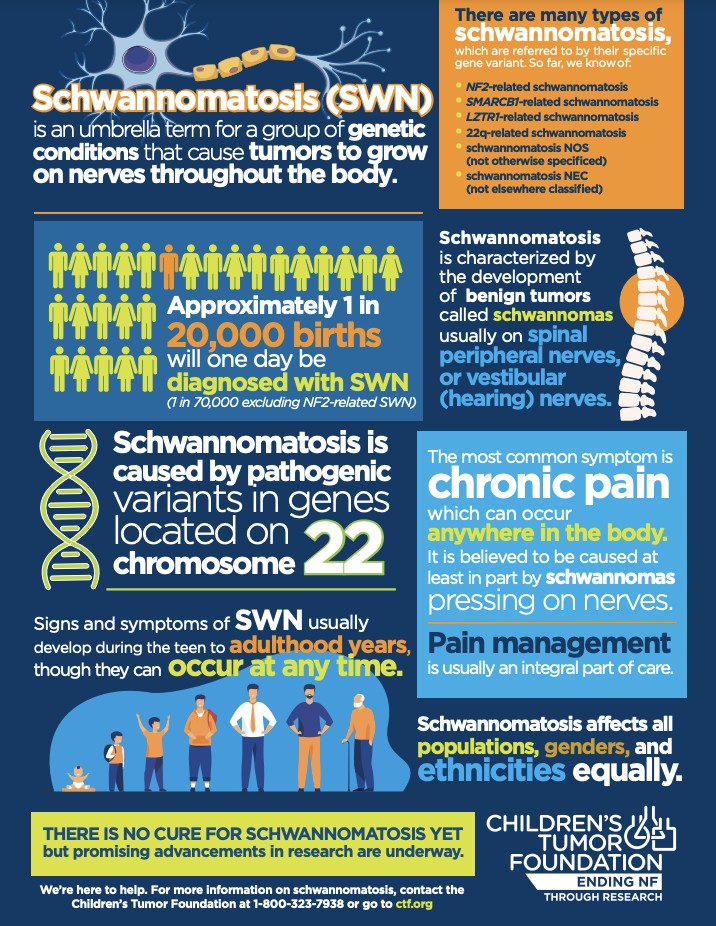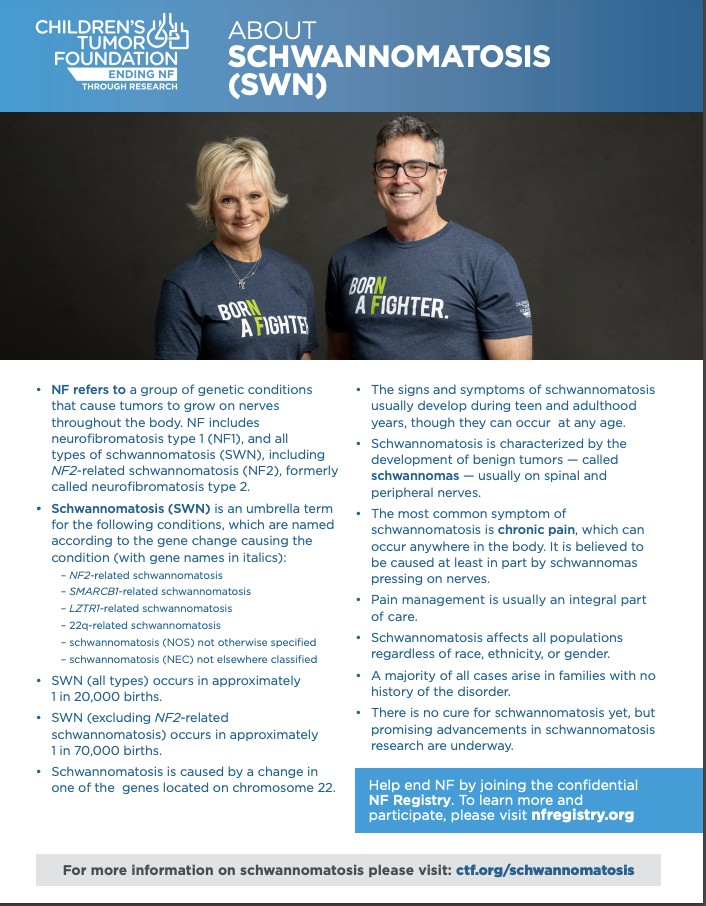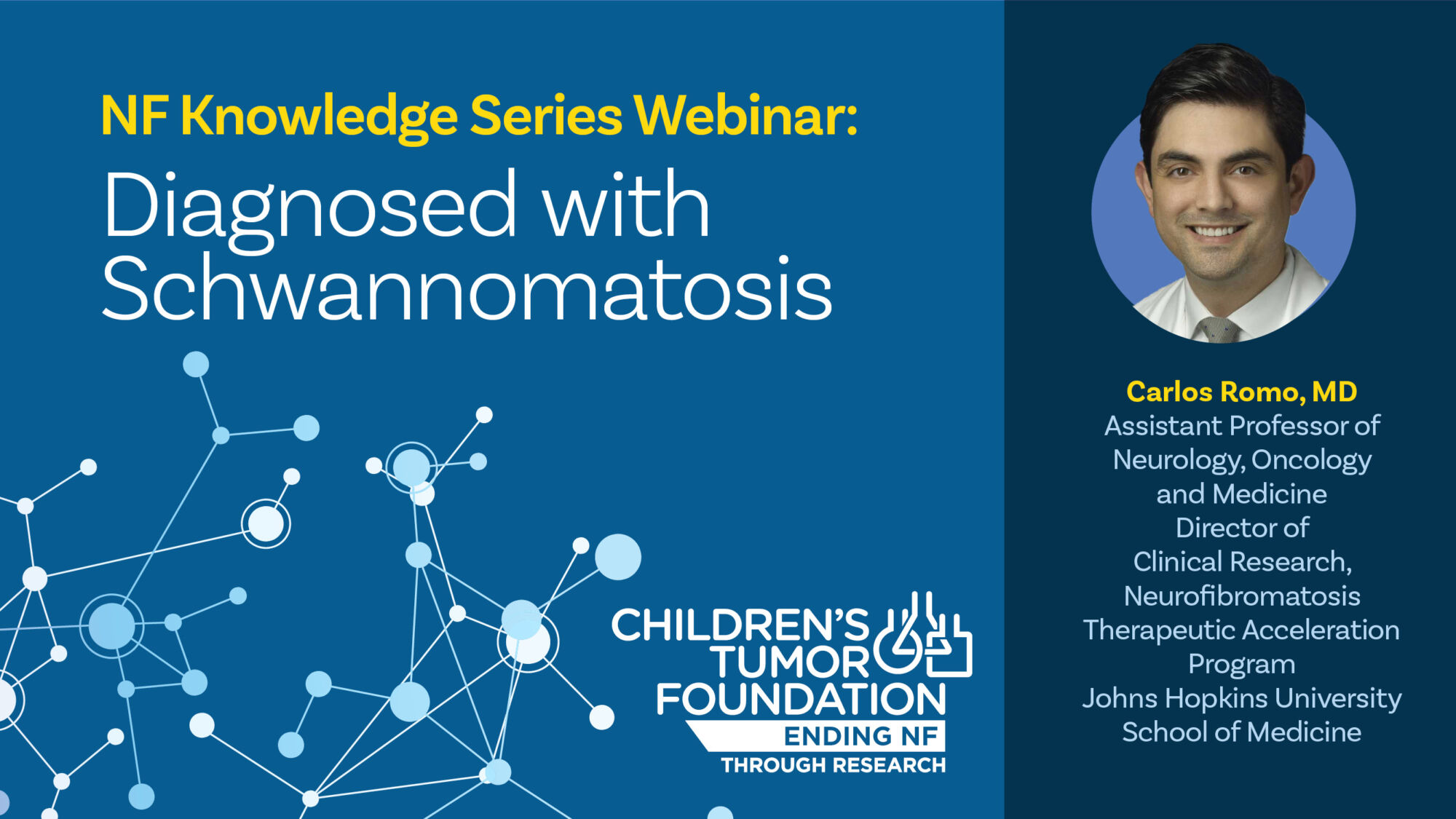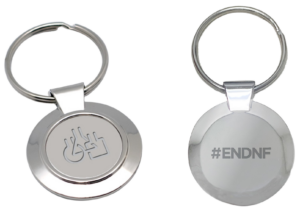Learn more about schwannomatosis (SWN)

Newly Diagnosed or Waiting for a Diagnosis?
Getting an NF diagnosis, or waiting for a diagnosis, can be overwhelming. The most important thing to remember is that you are not alone. We suggest starting your journey with these resources.
What is schwannomatosis?
NF refers to a group of genetic conditions that cause tumors to grow on nerves throughout the body. The types of NF include neurofibromatosis type 1 (NF1), and all types of schwannomatosis (SWN), which includes NF2-related schwannomatosis (NF2-SWN), formerly called neurofibromatosis type 2.
Schwannomatosis (SWN) is the least common and most recently identified form of NF. The term schwannomatosis is an umbrella term for several genetic conditions that cause the development of benign tumors to grow on nerves. Some type of SWN affects 1 in 20,000 people, with NF2-related schwannomatosis (NF2-SWN) the most common type of SWN. Excluding NF2-SWN, the other types of SWN affect just 1 in 70,000 individuals.
Schwannomatosis is a type of NF in which individuals develop tumors, called schwannomas, on nerves in the central nervous system (brain and spine) and on peripheral nerves, which are the nerves throughout the rest of the body. Schwannomas are benign, meaning they are not cancer. These tumors can affect patients in many ways, such as hearing loss, eye problems, or pain that may be hard to manage.
There are at least three genes, NF2, LZTR1, and SMARCB1 that are known to cause schwannomatosis, and there may be additional genes discovered in the future. These genes are thought to help regulate cell growth and division. If these genes are not functioning properly, the cells may multiply excessively and form tumors.
This page focuses on the less common forms of SWN. To learn more about NF2-SWN, click here.
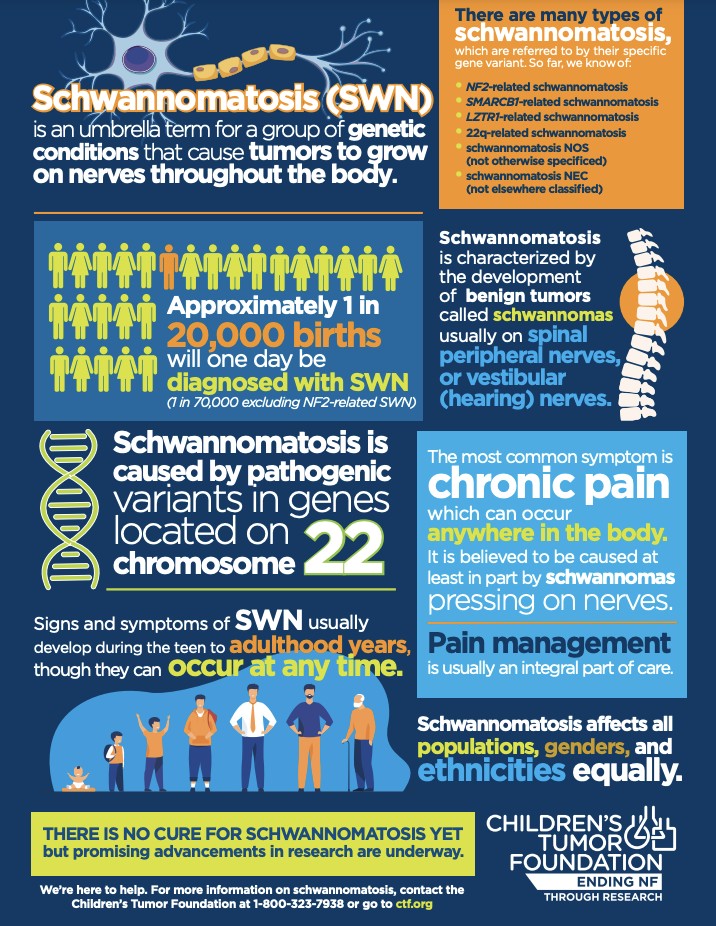
What are the manifestations or symptoms of schwannomatosis?
The first signs of schwannomatosis usually occur between the ages of 20 and 40, though they can begin at any age. The most common presenting symptom is pain, which can occur anywhere in the body and may or may not be in the area of a schwannoma. The intensity and frequency of pain varies significantly among individuals who are affected and, in some cases, the size of the tumor does not necessarily relate to the intensity level of the pain. While most people with schwannomatosis experience some degree of pain that requires medical management, a small number of people have only mild pain.
Some people with schwannomatosis develop many tumors throughout their body, while others may have only one or two tumors during their lifetime. In addition to schwannomas, another type of benign tumor, called meningiomas, may also occur, although much less frequently. In addition, a small subset of individuals develop tumors along the hearing/balance nerves, called vestibular schwannomas (or VS). Although the most common sign of schwannomatosis is pain, the tumors in schwannomatosis may occasionally press on nerves, causing numbness or tingling, muscle weakness, or loss of function.
How is schwannomatosis diagnosed?
The former diagnostic criteria for schwannomatosis (and NF2-SWN) classified patients primarily based on clinical features, however, it is now apparent that the manifestations of these diseases span the same continuum. For this reason, “schwannomatosis” no longer defines a distinct syndrome, but is now used as an umbrella term to describe the overlapping conditions in which a patient has many schwannomas.
All types of schwannomatosis are a result of a change in a gene (a sequence of DNA) located on chromosome 22. When a gene changes in a way that keeps it from working correctly, it is called a pathogenic variant (formerly called a gene mutation). Therefore, the different types of SWN are named by identifying the pathogenic variant that is the cause of the diagnosis, like so: GENE-related schwannomatosis (gene names are in italics).
So far, scientists have identified the following types of schwannomatosis:
- NF2-related schwannomatosis
- SMARCB1-related schwannomatosis
- LZTR1-related schwannomatosis
- 22q-related schwannomatosis
- Schwannomatosis NOS
- Schwannomatosis NEC

Because pain is often the main and presenting symptom, it may take several years before schwannomatosis is diagnosed and the source of the pain is identified. The degree of pain and tumors vary widely and some symptoms of schwannomatosis are shared with other conditions.
Healthcare providers use a list of diagnostic criteria (a checklist of signs and symptoms) to determine whether or not a patient may be given a diagnosis of a disorder or disease. A doctor will have to ask the patient many questions and thoroughly examine the individual’s body to determine whether the criteria is met. Often, a patient will be asked to have genetic testing using a blood or saliva sample, or to have all or part of a tumor removed so that it can be viewed under a microscope.
The diagnostic criteria in this summary were developed for healthcare providers, and it may be helpful in enhancing your understanding of the diagnostic procedures for SWN and in your discussions with clinicians about your own individual diagnosis.
What is the diagnostic criteria for schwannomatosis?
A diagnosis of SMARCB1-related schwannomatosis or LZTR1-related schwannomatosis can be made when a patient meets one of the following criteria:
- At least one pathologically confirmed schwannoma or hybrid nerve sheath tumor AND a SMARCB1 or LZTR1 pathogenic variant in an unaffected tissue such as blood or saliva
- A common SMARCB1 or LZTR1 pathogenic variant in two anatomically distinct schwannomas or hybrid nerve sheath tumors
- Note: diagnosis requires surgical specimen
A diagnosis of 22q-related schwannomatosis can be made when an individual does not meet criteria for NF2-related schwannomatosis, SMARCB1-related schwannomatosis, or LTZR1-related schwannomatosis, and has both of the following molecular features:
- Loss of heterozygosity (LOH) of the same chromosome 22q markers in two anatomically distinct schwannomas or hybrid nerve sheath tumors AND
- A different NF2 pathogenic variant in each tumor that cannot be detected in unaffected tissue
- Note: diagnosis requires at least two surgical specimens
A diagnosis of schwannomatosis-NOS (not otherwise specified) can be made if both of the following criteria are met and genetic testing was not performed or is not available:
- presence of two or more lesions on appropriate imaging consistent with non-intradermal schwannomas
- pathological confirmation of at least one schwannoma or hybrid nerve sheath tumor
A diagnosis of schwannomatosis-NEC (not elsewhere classified) can be made if both of the above criteria are met and genetic testing does not reveal a pathogenic variant in known schwannomatosis-related genes.
For more information on the diagnostic criteria for all types of schwannomatosis Click Here
Is there genetic testing for schwannomatosis?
Genetic testing for the genes known to be involved in all types of schwannomatosis is available and should be completed whenever possible for a patient suspected of SWN. Testing is required to diagnose a specific type of schwannomatosis, except NF2-related schwannomatosis, which does not require genetic testing if clinical criteria are met.
Genetic analysis can be performed using a blood or saliva sample but often requires tumor tissue if available. The penetrance of LZTR1- and SMARCB1-related schwannomatosis is reduced, and pathogenic variants in these genes may be associated with other conditions.
For guidance and information about genetic testing, it is important to talk with a physician specializing in diagnosing and treating schwannomatosis or speak with a genetic counselor.
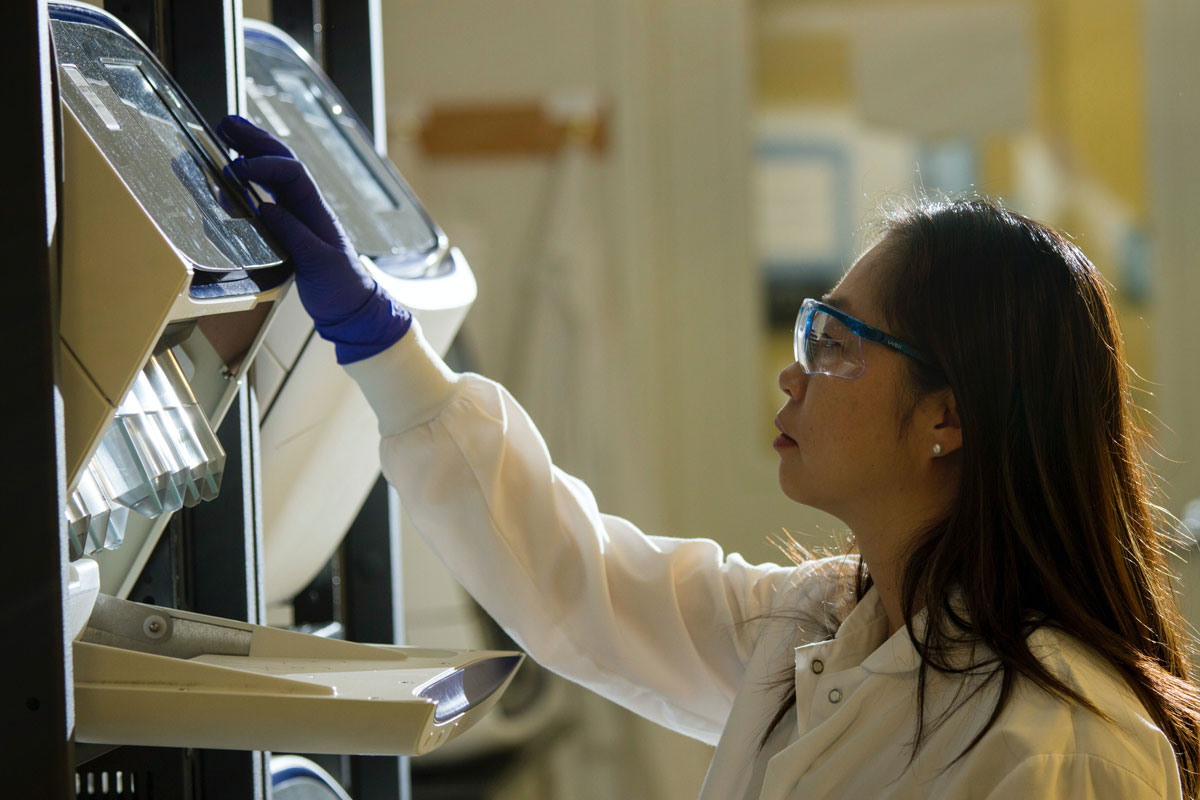

What is the treatment for schwannomatosis?
There is currently no cure for schwannomatosis, and no medication that has been shown to be effective in treating schwannomas. Management of the condition is based on each individual’s concerns. Surgical intervention to remove schwannomas can sometimes be done. Any time surgery is considered for a person with schwannomatosis, it is important that the surgeon is experienced with the condition to ensure the best possible outcome. In individuals for whom surgical removal of tumors is not possible, pain management is usually an integral part of care.
Individuals with schwannomatosis are best served in an NF clinic where multidisciplinary specialists experienced in schwannomatosis can administer pain management protocols that have been shown to be effective for people with this condition. In addition, the psychologic impact of living with chronic pain may lead to depression and anxiety which should be monitored in any individual with schwannomatosis. Interventions such as resiliency training, biofeedback, and other approaches may be beneficial.
Schwannomatosis Resources
View, download, or print our schwannomatosis materials. Additional resources may be found in our Resource Library.

